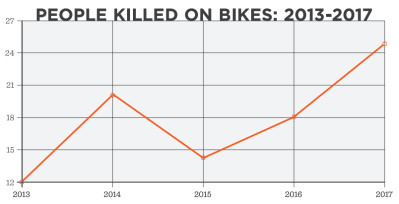269 People Killed in NYC Traffic Crashes Last Year

According to DOT data, 269 people died in traffic crashes on the streets of New York City last year, 11 more than in 2009. While that total shows New York City’s streets to be the safest of any major American city and less deadly than a generation ago, as Mayor Bloomberg said when announcing the same data last year, “even one traffic fatality is too many.”
The rise in traffic deaths last year was largely driven by a spike in crashes that killed motorcyclists, from 29 in 2009 to 39. The number of cyclist deaths also increased from 12 to 18. (In 2008, 26 cyclists were killed in traffic.)
More pedestrians lost their lives in traffic than any other category of victim: 151 pedestrians were killed by traffic in 2010, five fewer than the year before. Traffic crashes also killed 61 motorists and passengers, an increase of one from the previous year. The number of traffic injuries was not included in today’s data release, but is always orders of magnitude larger than the number of deaths.
One year’s worth of changes shouldn’t be taken to suggest a longer-term trend, but since 2001, traffic deaths have become substantially less frequent on the city’s streets. The total number of traffic fatalities in New York City fell 31 percent between 2001 and 2010, and pedestrian deaths dropped by 21 percent over the same period.
New York City’s unique transportation system makes it far safer than any other large American city. In part because so much of the population walks and takes transit rather than driving, the rate of traffic fatalities here is half that of other large American cities and one quarter the national average. “The low per-capita traffic fatality rate in NYC is real and is an important (and not sufficiently recognized) aspect of NYC’s overall quality of life,” said Charles Komanoff, author of “Killed by Automobile” [PDF].
Today’s announcement of traffic fatality information was lower key than last year’s announcement, where Transportation Commissioner Janette Sadik-Khan, Mayor Bloomberg, and NYPD traffic chief James Tuller all appeared at a press event. This year, the announcement was limited to a press release from DOT.
There were fewer traffic deaths in 2009 than in any other year since New York City started keeping records, and 2010 was the least deadly year after that. However, while some of the most dangerous intersections of 2001, like Herald Square, have been tamed, a DOT map showing each of the 269 traffic deaths displays clusters of road deaths in places like the Manhattan side of the Queensboro Bridge and the intersection of Kings Highway and Ocean Avenue.
Compared to other global cities, New York still has a lot of ground to make up on street safety. Tokyo and Berlin’s traffic fatality rates are less than half that of New York City.
In its announcement of the 2010 fatality information, DOT also reiterated its commitment to the pedestrian safety action plan it enacted last year. This year, that will include the city’s first 20 mph zone, sixty miles of safety upgrades to the most dangerous corridors, and twenty redesigned intersections on Manhattan’s deadly two-way arteries.
